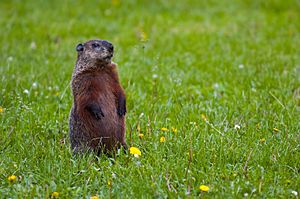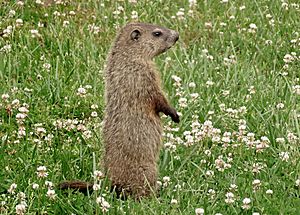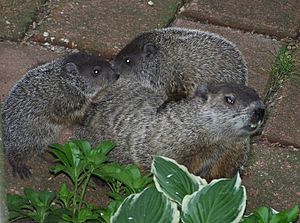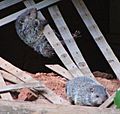Groundhog facts for kids
Quick facts for kids Groundhog |
|
|---|---|
 |
|
| Groundhog at Laval University campus, Quebec, Canada | |
| Conservation status | |
| Scientific classification | |
| Kingdom: | |
| Phylum: | |
| Class: | |
| Order: | |
| Family: | |
| Genus: | |
| Species: |
M. monax
|
| Binomial name | |
| Marmota monax |
|
The Groundhog is a type of rodent. It is also known as a Woodchuck or Whistlepig. Groundhogs are part of the ground squirrel family, which are also called marmots.
These animals are excellent diggers. They live in tunnels underground called burrows. Groundhog burrows are easy to spot. They are holes about 9 inches (23 cm) wide. You can usually see large piles of dirt and rocks at the entrance. Each burrow can have many tunnels. These tunnels can lead to up to ten other holes. They are very large and can have special rooms inside. Groundhogs build their homes under trees, near buildings, and in open fields.
Contents
Groundhog Behavior
Groundhogs are very good at swimming. They can also climb trees to escape from animals that hunt them. Sometimes, they climb trees to get a better view of their surroundings. When a groundhog feels threatened, it usually runs back to its burrow. If a predator enters its home, the groundhog will fight hard. It uses its two large incisors (front teeth) and sharp front claws.
Groundhogs are usually not very friendly with other groundhogs. They can be territorial and might fight to show who is in charge. Outside their burrow, groundhogs are always alert. You might see one or more groundhogs standing tall on their back feet. They do this to watch for danger. When they are scared, they make a loud, high-pitched whistle. This warns other groundhogs in the area. That is why they are sometimes called "whistle-pigs." Groundhogs might also squeal if they are fighting or hurt. They can also make low barks or grind their teeth. When a groundhog is frightened, the hair on its tail stands up. This makes its tail look like a brush.
What Groundhogs Eat
Groundhogs are mostly herbivorous. This means they mainly eat plants. They enjoy wild grasses and other plants. They also eat berries and farm crops when they can find them. In early spring, dandelions and coltsfoot are important foods for them. Other foods include sheep sorrel, timothy, buttercup, and different types of clover. They also like alfalfa, plantain, and wild lettuce.
Sometimes, groundhogs will eat small animals. These can include grubs, grasshoppers, insects, and snails. However, they do not eat as many different things as other squirrels. Like squirrels, they have been seen sitting up and eating nuts. But unlike squirrels, groundhogs do not bury nuts for later. An adult groundhog can eat more than a pound of plants every day. In early summer, their bodies start to slow down. They eat a lot to gain weight. This extra fat helps them survive during hibernation. Groundhogs do not store food for winter. Instead, they eat a lot to build up fat. They get the water they need from the plants they eat. Rain or dew on the plants also helps them stay hydrated.
Groundhog Burrows
Groundhogs are excellent at digging. They use their burrows for sleeping, raising their young, and hibernating. A groundhog burrow can be very large. One burrow was found to be 24 feet long. It also had two short side tunnels. The dirt dug out from this burrow weighed 640 pounds. Even though groundhogs are mostly solitary, a few might share the same burrow.
Groundhog burrows usually have two to five entrances. These entrances help groundhogs escape from predators quickly. The tunnels can be up to 14 metres (46 ft) long. They can be buried up to 1.5 metres (5 ft) deep underground. These large tunnels can sometimes cause problems for farms or buildings. However, it would take many groundhogs working for many years to damage a building's foundation.
The burrow is a safe place for groundhogs. They use it to hide from bad weather, sleep, and raise their babies. Inside the burrow, there is a special room for the nest. This room can be about 20 inches to 3 feet below the ground. It is usually about 16 inches wide and 14 inches high. There are typically two openings to the burrow. One is the main entrance, and the other is a hidden "spy hole." The length of a burrow often includes its side tunnels. One burrow was found to be almost 48 feet long in total. In cities, groundhogs tend to have fewer burrows. When young groundhogs are a few months old, they start digging their own small holes. These holes are often shallow and not always used. But they make it seem like groundhogs live in large groups.
Hibernation
Groundhogs are one of the few animals that truly hibernate. They often dig a separate "winter burrow" for this purpose. This burrow is usually in a wooded area. It is dug deep enough to stay above freezing temperatures all winter. In most places, groundhogs hibernate from October to March or April. In warmer areas, they might only hibernate for three months. Groundhogs in colder northern areas hibernate longer than those in the south.
To survive the winter, they eat a lot and gain maximum weight before hibernating. When a groundhog hibernates, its body temperature drops very low. It can go down to about 35 degrees Fahrenheit (1.7 degrees Celsius). Their heart rate slows to 4-10 beats per minute. Their breathing slows to just one breath every six minutes. During hibernation, they go through periods of deep sleep and then wake up briefly. They wake up from hibernation with some body fat left. This fat helps them until spring brings new plants to eat. Male groundhogs usually wake up from hibernation before females. Groundhogs are mostly active during the day. You can often see them in the early morning or late afternoon.
Groundhog Reproduction and Life Cycle
Most groundhogs start to breed when they are two years old. Some might breed in their first year. The breeding season is from early March to mid- or late April. This happens after they wake up from hibernation. A male and female groundhog will stay in the same burrow during the 31- to 32-day gestation period. As the babies are about to be born in April or May, the male leaves the burrow.
Groundhogs have one litter of babies each year. A litter usually has two to six young. The babies are born blind, hairless, and helpless. The mother groundhog introduces her young to the outside world once their fur has grown and they can see. Around this time, the father groundhog might return to the family. The parents encourage their young to learn by copying their actions. By the end of August, the family separates. Most of the young groundhogs scatter to dig their own burrows.
In Culture
In the United States, there is a special holiday called Groundhog Day. It is celebrated every year on February 2.
Images for kids
-
Groundhog gathering material for its warm burrow nest.
-
A close encounter with a human photographer at Sheldon Marsh State Nature Preserve, Ohio
See also
 In Spanish: Groundhog para niños
In Spanish: Groundhog para niños











